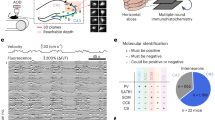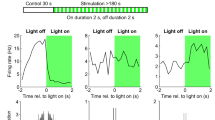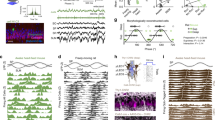Abstract
Neural-network oscillations at distinct frequencies have been implicated in the encoding, consolidation and retrieval of information in the hippocampus. Some GABA (γ-aminobutyric acid)-containing interneurons fire phase-locked to theta oscillations (4–8 Hz) or to sharp-wave-associated ripple oscillations (120–200 Hz), which represent different behavioural states1,2,3,4,5,6. Interneurons also entrain pyramidal cells in vitro7. The large diversity of interneurons8,9,10 poses the question of whether they have specific roles in shaping distinct network activities in vivo. Here we report that three distinct interneuron types—basket, axo-axonic and oriens–lacunosum-moleculare cells—visualized and defined by synaptic connectivity as well as by neurochemical markers, contribute differentially to theta and ripple oscillations in anaesthetized rats. The firing patterns of individual cells of the same class are remarkably stereotyped and provide unique signatures for each class. We conclude that the diversity of interneurons, innervating distinct domains of pyramidal cells11, emerged to coordinate the activity of pyramidal cells in a temporally distinct and brain-state-dependent manner.
This is a preview of subscription content, access via your institution
Access options
Subscribe to this journal
Receive 51 print issues and online access
$199.00 per year
only $3.90 per issue
Buy this article
- Purchase on SpringerLink
- Instant access to full article PDF
Prices may be subject to local taxes which are calculated during checkout




Similar content being viewed by others
References
O'Keefe, J. & Nadel, L. The Hippocampus as a Cognitive Map (Clarendon, Oxford, UK, 1978)
Fox, S. E. Membrane potential and impedance changes in hippocampal pyramidal cells during theta rhythm. Exp. Brain Res. 77, 283–294 (1989)
Ylinen, A. et al. Sharp wave-associated high-frequency oscillation (200 Hz) in the intact hippocampus: Network and intracellular mechanisms. J. Neurosci. 15, 30–46 (1995)
Ylinen, A. et al. Intracellular correlates of hippocampal theta rhythm in identified pyramidal cells, granule cells, and basket cells. Hippocampus 5, 78–90 (1995)
Csicsvari, J., Hirase, H., Czurko, A., Mamiya, A. & Buzsáki, G. Oscillatory coupling of hippocampal pyramidal cells and interneurons in the behaving rat. J. Neurosci. 19, 274–287 (1999)
Buzsáki, G. Theta oscillations in the hippocampus. Neuron 33, 325–340 (2002)
Cobb, S. R., Buhl, E. H., Halasy, K., Paulsen, O. & Somogyi, P. Synchronization of neuronal activity in hippocampus by individual GABAergic interneurons. Nature 378, 75–78 (1995)
Freund, T. F. & Buzsáki, G. Interneurons of the hippocampus. Hippocampus 6, 347–470 (1996)
Fricker, D. & Miles, R. Interneurons, spike timing, and perception. Neuron 32, 771–774 (2001)
McBain, C. J. & Fisahn, A. Interneurons unbound. Nature Rev. Neurosci. 2, 11–23 (2001)
Buhl, E. H., Halasy, K. & Somogyi, P. Diverse sources of hippocampal unitary inhibitory postsynaptic potentials and the number of synaptic release sites. Nature 368, 823–828 (1994)
Traub, R. D. et al. Axonal gap junctions between principal neurons: A novel source of network oscillations, and perhaps epileptogenesis. Rev. Neurosci. 13, 1–30 (2002)
Vanderwolf, C. H. Cerebral activity and behavior: Control by central cholinergic and serotonergic systems. Int. Rev. Neurobiol. 30, 225–340 (1988)
Pinault, D. A novel single-cell staining procedure performed in vivo under electrophysiological control: Morpho-functional features of juxtacellularly labeled thalamic cells and other central neurons with biocytin or neurobiotin. J. Neurosci. Methods 65, 113–136 (1996)
McBain, C. J., DiChiara, T. J. & Kauer, J. A. Activation of metabotropic glutamate receptors differentially affects two classes of hippocampal interneurons and potentiates excitatory synaptic transmission. J. Neurosci. 14, 4433–4445 (1994)
Sik, A., Penttonen, M., Ylinen, A. & Buzsáki, G. Hippocampal CA1 interneurons: An in vivo intracellular labeling study. J. Neurosci. 15, 6651–6665 (1995)
Ali, A. B. & Thomson, A. M. Facilitating pyramid to horizontal oriens–alveus interneurone inputs: Dual intracellular recordings in slices of rat hippocampus. J. Physiol. (Lond.) 507, 185–199 (1998)
Maccaferri, G., Roberts, J. D. B., Szucs, P., Cottingham, C. A. & Somogyi, P. Cell surface domain specific postsynaptic currents evoked by identified GABAergic neurones in rat hippocampus in vitro. J. Physiol. (Lond.) 524, 91–116 (2000)
Nakazawa, K. et al. Requirement for hippocampal CA3 NMDA receptors in associative memory recall. Science 297, 211–218 (2002)
Brun, V. H. et al. Place cells and place recognition maintained by direct entorhinal–hippocampal circuitry. Science 296, 2243–2246 (2002)
Gillies, M. J. et al. A model of atropine-resistant theta oscillations in rat hippocampal area CA1. J. Physiol. (Lond.) 543, 779–793 (2002)
Spruston, N., Schiller, Y., Stuart, G. & Sakmann, B. Activity-dependent action potential invasion and calcium influx into hippocampal CA1 dendrites. Science 268, 297–300 (1995)
Harris, K. D., Hirase, H., Leinekugel, X., Henze, D. A. & Buzsáki, G. Temporal interaction between single spikes and complex spike bursts in hippocampal pyramidal cells. Neuron 32, 141–149 (2001)
Skaggs, W. E., McNaughton, B. L., Wilson, M. A. & Barnes, C. A. Theta phase precession in hippocampal neuronal populations and the compression of temporal sequences. Hippocampus 6, 149–172 (1996)
Mehta, M. R., Lee, A. K. & Wilson, M. A. Role of experience and oscillations in transforming a rate code into a temporal code. Nature 417, 741–746 (2002)
Harris, K. D. et al. Spike train dynamics predicts theta-related phase precession in hippocampal pyramidal cells. Nature 417, 738–741 (2002)
Katona, I., Acsady, L. & Freund, T. F. Postsynaptic targets of somatostatin-immunoreactive interneurons in the rat hippocampus. Neuroscience 88, 37–55 (1999)
Magee, J. C. & Johnston, D. A synaptically controlled, associative signal for Hebbian plasticity in hippocampal neurons. Science 275, 209–213 (1997)
Losonczy, A., Zhang, L., Shigemoto, R., Somogyi, P. & Nusser, Z. Cell type dependence and variability in the short-term plasticity of EPSCs in identified mouse hippocampal interneurones. J. Physiol. (Lond.) 542, 193–210 (2002)
Zar, J. H. Biostatistical Analysis (Prentice Hall, New Jersey, 1999)
Acknowledgements
We thank G. Horseman and S. Gray from Cambridge Electronic Design, and P. Jays and L. Norman for technical assistance. We thank Z. Nusser, G. Tamas and J. Csicsvari for critically reading an earlier version of the manuscript, and Y. Dalezios for help with the statistics. T.K. was supported by an Erwin Schroedinger Fellowship from the Austrian Science Fund during part of this study; G.B. was supported by the National Institutes of Health.
Author information
Authors and Affiliations
Corresponding author
Ethics declarations
Competing interests
The authors declare that they have no competing financial interests.
Supplementary information
Rights and permissions
About this article
Cite this article
Klausberger, T., Magill, P., Márton, L. et al. Brain-state- and cell-type-specific firing of hippocampal interneurons in vivo. Nature 421, 844–848 (2003). https://doi.org/10.1038/nature01374
Received:
Accepted:
Issue Date:
DOI: https://doi.org/10.1038/nature01374



